Tropical Aquarium Fishes
Water aquariums are a great addition to any interior, being vivid in colours and helping us relax and have fun. Fish breeding is also a great hobby. You can spend time watching your beautiful tropical aquarium fish swimming or occasinally show them to your guests. Do you feel excited about it? If so, read about freshwater fishes, which you can settle in your aquarium without any trouble.
Which Tropical Aquarium Fish Should Be Chosen?
The following tropical aquarium fishes are popular with all fish enthusiasts and are considered to be suitable not only for advanced breeders, but also for beginners:
- Neon Tetra;
- Swordtail;
- Fancy Guppy;
- Cory Catfish (Corydoras);
- Black-Skirt Tetra.
- Zebra Danio.
- Cherry Barb.
- Harlequin Rasbora.
Neon Tetra
Neons are believed to be of the most popular of freshwater fishes because of their small size and bright colors. Their breeding is also easy, and there is no need to arrange special conditions for them.
Description
Fish only becomes approximately an inch long, therefore, an aquarium that exceeds 10 gallons will be an appropriate home. Main appearance features are versicolor blue stripe lengthwise the body and red stripe from the middle of the body to the caudal fin.
In The Aquarium
Neons are schooling fish and require a school of at least six species or more. They are very obedient and easy to care.
Swordtail
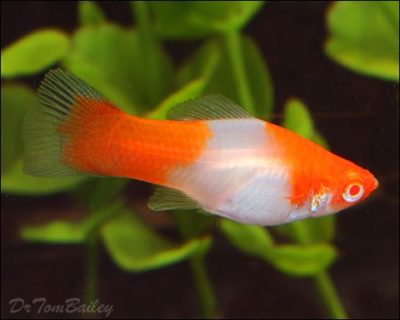
Swordtail is another species that is in a great request as aquarium fish.
Description
Naturally, they have an olive body with red or dark yellow stripes along the body. That’s why they called Red or Green Swordtail. Males gave the name for these species as they have sword-like extension of their tail fins. Male swordtails can grow up to 5.5 inches long, while females reaches maximum of 6 inches.
In The Aquarium
Despite of the sword, swordtails are not aggressive, but very attentive to females. So, it is recommended to have two females for one male.
Guppy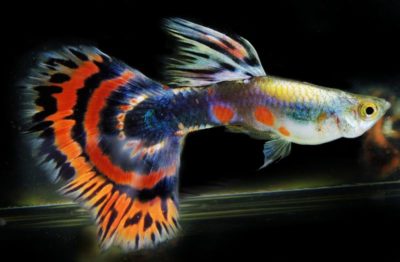
Guppy is probably the famous and most distributed tropical aquarium fish in the world.
Description
Thanks to breeders, guppies are presented in various colors, shapes and patterns. As a rule, they have tiny bodies – up to 1.4 inches long in males and up to 2.4 inches in females – and big fins (in relation to the body), which sizes vary widely.
In The Aquarium
Guppies are very active, so if you need to add movement and colors in your aquarium, you can choose them. Remember that due to their small size it is not recommend keeping them with larger fishes in the same tank.
Corydoras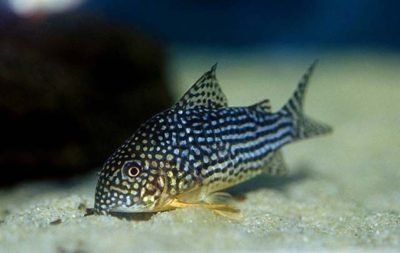
“Сorydoras“ is a combination of Greek words “kory“ (helmet) and “doras“ (skin). Their genus has over 160 species, which is the largest one in the Neotropical realm. Corydoras is also known as cory catfish.
Description
Cories are favorites of many aquarists for their ornamental patterns. The overall length of most of them not exceeds 2-3 inches, but some species a bit larger – the emerald cory, for instance.
In The Aquarium
Corydoras are bottom-dwellers, so sinking food should be provided. Otherwise, there is a risk of food interception by fast-moving fishes at the top of the tank. Cories are quite timid and not aggressive, that’s why they should be kept in shoals of 3-6 or more.
Black-Skirt Tetra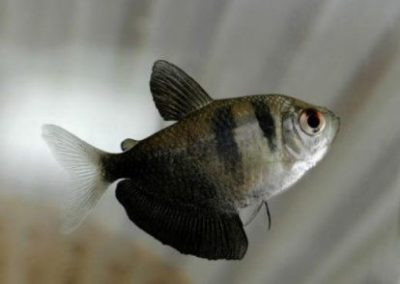
Black-skirt tetra, also called black widow tetra, is a very pretty fish often kept in aquariums.
Description
The main features of the appearance are almost tetragonal body, two black vertical bars located behind the gills and dark flowing fins. Black-Skirt Tetra grows up to 3 inches in length.
In The Aquarium
This schooling fish is docile and easy to care, but requires a shoal up to six species and enough space to swim, so you may need a tank of extended size (at least 20 gallons is recommended).
Zebra Danio
The zebrafish (zebra danio) will be definitely an active and cute addition to your tropical fish aquarium.
Description
Zebra danio have received its name for five horizontal stripes along the body, a pattern that a similar to zebra’s. But, unlike zebra, these stripes are blue and alternated with gold ones in males and silver ones in females. Their maximum length is 2.5 inches. While standard danio has short fins, long-finned and lyre-tail variations.
In The Aquarium
Zebrafishes are hardy and tolerant to various conditions. They also can be used for calming other fishes in the tank. As any mentioned shoaling fishes, they should be kept in a group of at least six species.
Cherry Barb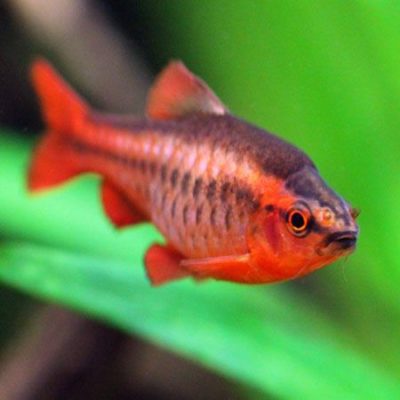
This cute, peaceful and community fish is a perfect choice for aquarium beginners. Bright red color of males make them really pops.
Description
This fish has elongated body that reaches 2 inches long. Its top is fawn-colored with a slight greenish shine; sides and belly are highlighted with silver sheen. The notable feature is dark horizontal stripe from the tip of the snout along the body to the tail.
In The Aquarium
Being a schooling fish, cherry barb is better to keep in groups of six individuals or more. Naturally, their shoals are not tight as other fishes have, but in the event of danger, they dashingly group together. As a rule, young males are peaceful, while elder ones may show the aggression when breeding.
Harlequin Rasbora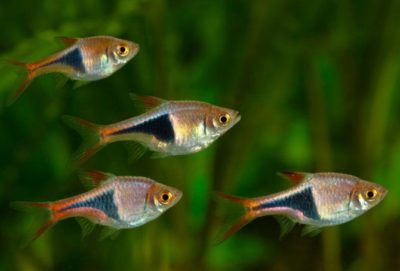
This small fish is very notable among their tankmates due to the appearance. That’s why it is appreciable by hobbyists.
Description
Harlequins are small – up to 2 inches, and attractive due to their “costumes” with a black triangular spots on their bodies that are reminiscent to the pattern of harlequin’s apparel.
In The Aquarium
This is a shoaling fish too, which needs enough space to swim. Hardy and active, harlequins are friendly enough to get along with other dwellers in the aquarium.
Are you ready to dive into the colorful freshwater fish world? We hope, this brief review will help you start new or diversify your current hobby. By the way, if you want to find out how tropical fish reproduce, then read this article.
